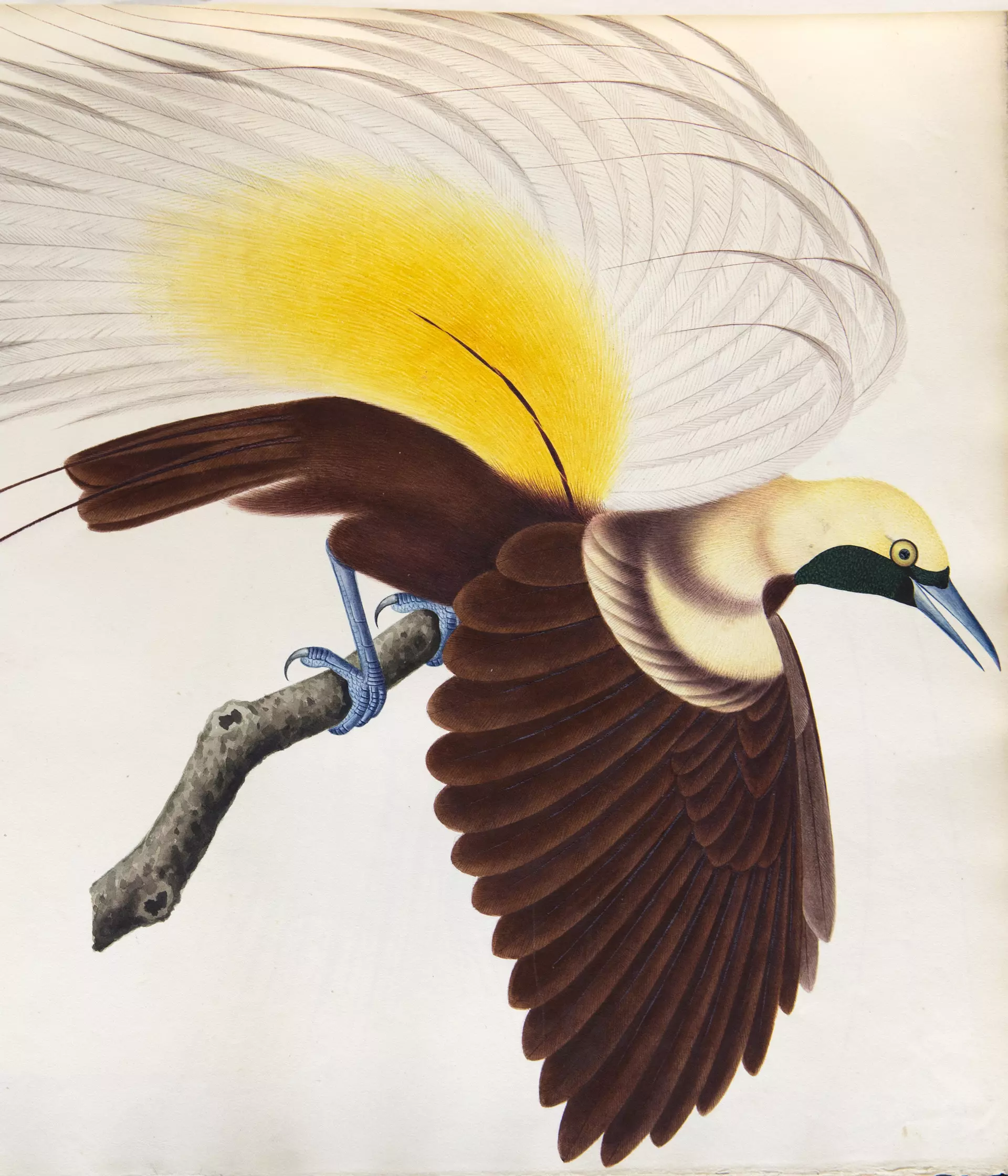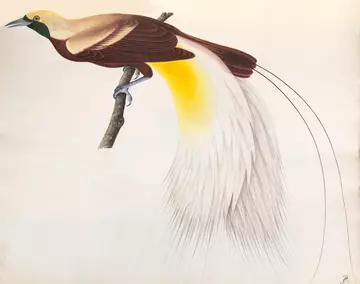
Ann Sylph, MSc, MCLIP
ZSL Librarian
The Reeves album of early nineteenth-century watercolours of animals is one of the gems of Chinese natural history art.
Ann Datta our Volunteer Art Cataloguer has recently had a paper published in the Archives of Natural History - Nineteenth-century Chinese watercolours of Paradisaea minor in the library of the Zoological Society of London. We asked her to blog about these watercolours... here is the result.
The Reeves album of early nineteenth century watercolours of animals is one of the gems of Chinese natural history art: the rich colours and patterns of the animals, faithfully copied in meticulous detail to afford scientific identification, combine with artistic flare to contribute to the beauty of this special collection. Yet it differs from most comparable collections of natural history drawings in two respects: most sheets have no European manuscript annotations and some of the most arresting drawings are of species not found in China in nature, eg macaws which live in South America.
Reeves' Background
John Reeves (1774-1856) was the East India Company’s (EIC) Inspector of Teas in China for 19 years (1812-1831). At the time there were few Europeans in China and their movements in the country were restricted. Naturalists in Britain saw an opportunity through Reeves to discover and learn about its plants and animals. They taught and showed Reeves, who did not have knowledge of natural sciences, what to collect, and how to preserve it and pack it for safe shipment to England. All natural history was of interest but especially beautiful flowering shrubs and plants like azaleas and camellias, which they wanted to import for English gardens. Reeves had time for natural history in Macau where he ‘rested’ for half the year when he was not engaged on official duties from September to March in the factories in Canton (now called Guangzhou).

The ZSL album
The ZSL album was donated in 1877 by Reeves’ daughter-in-law, Elizabeth Reeves whose husband and father-in-law were both Fellows of the Society. The subjects include mammals, birds, reptiles, fishes and invertebrates depicted on 128 sheets by unidentified Chinese artists. With the exception of the drawings of fishes, described by the Natural History Museum (NHM) researcher, the late Peter Whitehead (1930-1993), that have some English annotations and associated notebooks held in the NHM, most of the other drawings are devoid of any data necessary for scientific study, eg place collected, date, or name. Without it, drawings usually have a limited scientific value.
From other evidence, however, it is possible to make an informed guess that Reeves found many of these animals living in captivity in Macau. George Bennett (1804-1893), a British surgeon naturalist, described Macau in 1833. Like other visitors, he was stunned by the beautiful gardens of the Chinese merchants and by that of Thomas Beale (1775-1842) an English merchant whose aviary and garden were the top visitor attractions. In 45 pages Bennett described Beale’s collections, eleven pages of which were used to describe an extraordinary male Lesser Bird of Paradise (Paradisaea minor), a bird originally found in New Guinea (Bennett 1834 : 2 : 36-81 (Lesser Bird of Paradise 37-48). This bird had ‘personality’ and performed to the delight of the audience. The visitors may have seen stuffed specimens and coloured engravings of the Lesser Bird of Paradise but this live bird was a spectacle not to miss. It is well-known that naturalists copied and exchanged drawings and drew Museum specimens I think we can be sure that this living bird was the subject for two paintings in Reeves album, in one of which the bird is displaying and raising its plumage (ZSL Library Reeves album ff. 14B, 15).
Piecing together the details
Harriett Low (1809-1877) was an earlier visitor from America who described Beale’s aviary in 1829 and the Lesser Bird of Paradise. Interestingly, she mentions meeting ‘Mr. Reeves’ but this may be a reference to John Russell Reeves (1804-1877) the son of John Reeves. There is less known or published about life in China for EIC employees than in India but it is obvious that it was very comfortable for senior employees like Reeves (Low 2002).
Bennett noted many of the exotic animal’s in Beale’s aviary: “loris .. King Parrot of New South Wales .. Indian ring-neck parroquet” (Bennett 1834 : 2 : 49); “Reeve’s Pheasant … Horned Tragopan … Mandarin Teal … Nicobar pigeons … Pink cockatoo … the Ounderou monkey of Ceylon … “ (Bennett 1834 : 2 : 55, 50, 62, 65, 67). It was a snapshot of animals living there in 1833. Over the years it would change as more animals arrived and others died.
Extrapolating, it seems likely that Beale’s collection of animals and his gardens provided the raw materials for Reeves’ artists and Reeves did not have to send out collectors far as there was abundant new material on his doorstep. Chinese artists are famous for their meticulous paintings and having a continuous supply of fresh, living plants and live animals enabling examination at close range, would have aided the veracity of their drawings.
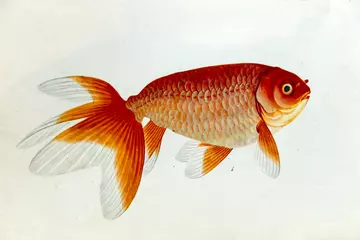
Both John and J.R. Reeves supplied zoological specimens to the British Museum (Natural History) and Zoological Society. Reeves was an amateur naturalist who did not attempt to identify or name the Chinese zoological drawings held by the Reeves family until 1877. To appreciate their beauty privately it was not necessary to annotate them with dates and places or try to put names on them. And, if Beale was the source for most, Reeves would probably not consider it necessary to add Beale’s name. Beale’s collections in Macau were well-known to contemporary naturalists (a reptile was named after him – Beolens et al 2011 : 20) but with the passage of time the Reeves-Beale connection was lost.
However, written discreetly on each painting of native Chinese animals is the Chinese word for it in Chinese characters, thought to have been added by the artist. These names are noticeably absent from drawings of foreign species (eg. Bird of Paradise, Macaws) presumably because there was no Chinese equivalent name for them. An index of the animals depicted in the album, with modern scientific identification and Chinese names compiled by Ping Chen, 2012 is available ( and can be downloaded from ZSL’s online catalogue, search by typing in the ID no. ART10000099).
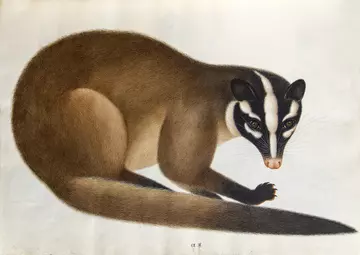
The situation with the plants and botanical drawings Reeves obtained for the Horticultural Society, which had a commercial interest in them, was different, however. Reeves was commissioned and paid for this work. Not only are the drawings annotated in English but letters and other associated manuscripts are preserved with them (Bailey & Brooks 2018 : 37).
Finally, in retirement in England, it is recorded that a Mr. Reeves (John Reeves or J.R. Reeves) called at the house of John Gould (1804-1881), the ornithologist and taxidermist, in 1839 and 1840 for his bird of paradise and other specimens. (Sauer 1998 : 10, 36, 176 : other animals noted on pp. 25, 86).
Using the Lesser Bird of Paradise as an example there is evidence that Reeves’s artists made extensive use of animals living in Beale’s aviary. Reeve’s did not annotate the drawings because he could not identify the animals and at the time it would not have been considered important to date the paintings and add the location.
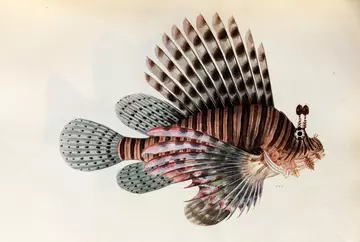
Read Ann Datta's published paper - Nineteenth-century Chinese watercolours of Paradisaea minor in the Library of the Zoological Society of London. Archives of natural history 45(2) : 363-366.
References and further reading
Bailey, K. & Brooks, C. 2018. The RHS Reeves collection : what’s in a name? Occasional papers from the RHS Lindley Library 16 : 33-76 illust.
Bennett, G. 1834. Wanderings in New South Wales, Batavia, Pedir Coast, Singapore and China. (London : Richard Bentley) 2vols. https://www.biodiversitylibrary.org/item/88785#page/60/mode/1up (Vol. 2 : viewed 2/10/2018)
Beolens, B., Watkins, M. & Grayson, M. (2011). The eponym dictionary of reptiles (Baltimore : The Johns Hopkins University Press).
Datta, A. Nineteenth-century Chinese watercolours of Paradisaea minor in the Library of the Zoological Society of London. Archives of natural history 45(2) : 363-366.
https://www.euppublishing.com/doi/abs/10.3366/anh.2018.0526
Fan, F. 2004. British naturalists in Qing China. Science, empire, and cultural encounter. (Cambridge, Massachusetts).
Lamas, R.W.N., 2006. Everything in style : Harriett Low’s Macau. Hong Kong University Press. 364 pp.
Low, H. 2002. Lights and shadows of a Macao life. The journal of Harriett Low, travelling spinster. Part 1 : 1829-1832. N.P. Hodges & A.W. Hummel (editors) (Woodinville, Washington).
Magee, J. 2011. Chinese art and the Reeves collection. (London):Natural History Museum)
Reeves, J. c1820-1840 (most c1826). Animals in the Reeves's collection. 128 art originals c 50x39 cm or smaller.[Unpublished] ZSL Library ID no. ART10000099
Sauer, G.C., 1998. John Gould the bird man: Correspondence. Vol. 2 1839 through 1841. (Mansfield Centre, CT : Maurizio Martino Publisher in association with The Natural History Museum).
Whitehead, P.J.P. 1969. The Reeves collection of Chinese fish drawings. Bulletin of the British Museum (Natural History) Historical series 3(7) : 191-233 29 pls.
Whitehead, P.J.P. & Edwards, P. I. 1974. Chinese natural history drawings: selected from the Reeves collection in the British Museum (Natural History) London.
